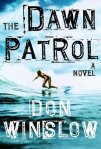
In three of the five states I’ve read so far, a character in one of the state’s books finds a dead body beneath the surface of water: in the bayou in Alabama’s Train Whistle Guitar, in the Mississippi River in Arkansas’s “Ark of Bones;” and in the Pacific Ocean in California’s Cannery Row. This wouldn’t seem odd to me – dead bodies make for interesting stories, right? – except that in all three cases our protagonist happens upon the body, reacts or doesn’t react, and then the event disappears from the story. The characters take no action, the discoveries do not cause later trauma, and though I keep expecting the story to come back to it, the body is never referred to again beyond the scene in which the character finds it.
The first time this happened, when I read Albert Murray’s Train Whistle Guitar, I waited for the body to reemerge in the narrative, and when it didn’t, I was confused as to why it was there in the first place. When it happened again, in Henry Dumas’s “Ark of Bones,” the language of the discovery was eerily similar.
He seemed to be a white man, but you couldn’t really be certain about that either. All I could make out was that he was a dead man.- Albert Murray ¹
His body was so ate up by fish and crawdads that they couldn’t tell whether he was white or black. Just a dead man. – Henry Dumas ²
In both of these stories, the protagonists who happen upon the bodies are young African American boys, and in both cases, the author makes a point of telling us that the race of the dead man is indeterminable. In both cases the young boys leave the bodies and take no action; they find the corpses, note them, and the stories continue, influenced in no way that I could discern by the discoveries of the bodies.
Similarly, in Cannery Row, marine biologist Doc discovers a dead body trapped beneath a rocky ledge when he is on an octopus-collecting expedition at low tide. Unlike the Mississippi River bodies, this Pacific Ocean body is intact – a girl with hair that swirls with the ocean’s movements, white faced and with eyes open – and Doc is momentarily traumatized. He staggers back to shore, gasps for air, and when a passerby asks if he’s okay, he stutters about the body, is too troubled to call the police himself – can the bystander please do it? – and the body never appears again in the story.
The scene in Cannery Row is awfully dramatic for us never to return to it. I would have been jarred by it without two other books already featuring floating corpses, but together with the Murray and Dumas bodies, Steinbeck’s deserted corpse – the third of its kind – alerted me that perhaps I am missing something. Many writers know Chekhov’s rule:
If you say in the first chapter that there is a rifle hanging on the wall, in the second or third chapter it absolutely must go off. If it’s not going to be fired, it shouldn’t be hanging there. ³
All three of these writers – Murray, Dumas, Steinbeck – are accomplished authors who know what they are doing. And all three put dead bodies in their works. Why are those bodies there? Random corpses have appeared in 3 out of 15 books I’ve read since I began my Andrea Reads America project. Is this an American lit thing, and if so, what’s it all about?
In the Murray and Dumas stories the bodies may make a larger point about race: in death we are all the same, indistinguishable by the color of our skin. That is an important point that struck me about those passages, and one that I still carry with me, that we are all the same in death – why not in life, too? The corpses also reveal some things about place: their existence suggests a place of violence and murder, and the fact that the bodies have gone undiscovered indicates an isolated, rural setting.
The purpose of the Steinbeck body is not as clear to me. It plays an immediate role of putting Doc in a state of confusion and vulnerability, but beyond that I am at a loss. He does not reflect on his own mortality later, or at least not in a way that was obvious to me.
I am alert now to these bodies as I read my way across the US. Perhaps I won’t come across another; perhaps it’s just coincidence that three piled up at the beginning of my tour. I plan to keep a body count, though, and to read closely if I come across another corpse. Because to me, these corpses are like Chekhov’s gun: they are hanging there on the wall, why did they not go off?
Can you recall a similar story, with a dead body that is discovered and never discussed again? What are your thoughts on the purpose of these corpses?
¹ Murray, Albert. Train Whistle Guitar. New York: McGraw-Hill Book Company. 1974. Print.
² Dumas, Henry. Ark of Bones and Other Stories. Carbondale: Southern Illinois University Press. 1975. Print
³ Valentine, Bill T. Chekhov: The Silent Voice of Freedom. New York: Philosophical Library. 1987. Print.




